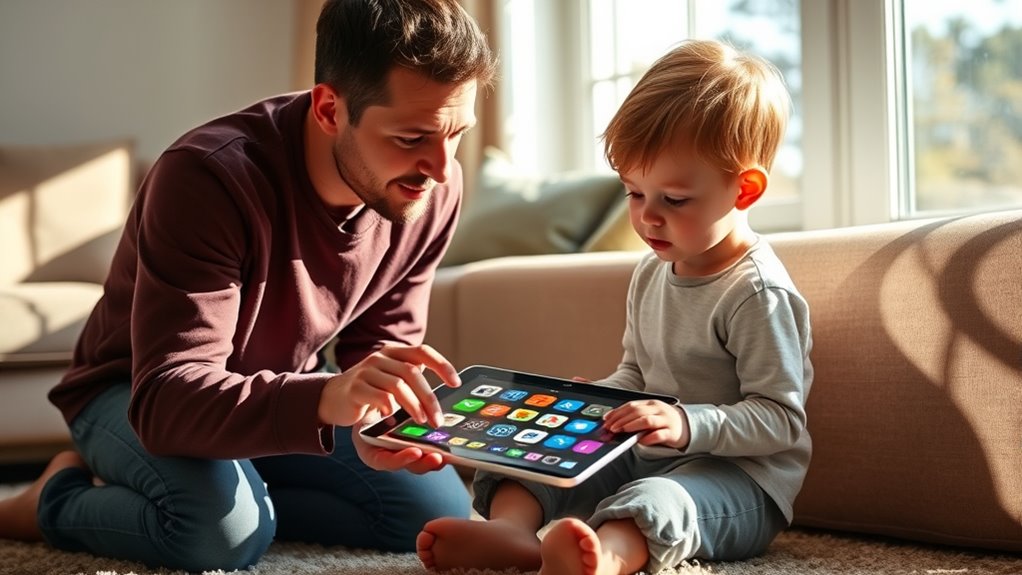Talking to your kids about privacy and online safety is key to helping them navigate the digital world responsibly. Encourage open conversations about cyberbullying, digital footprints, and setting privacy controls. Teach them to use strong passwords, recognize suspicious links, and avoid sharing personal info like their full name or address. Regular supervision and ongoing dialogue build trust and guarantee they understand how to stay safe online. Keep exploring to learn effective ways to guide your children confidently.
Key Takeaways
- Use age-appropriate language to explain online privacy, emphasizing the importance of keeping personal information private.
- Encourage children to think before sharing content, highlighting how digital footprints can impact their future.
- Teach kids to set social media profiles to private and to only accept friend requests from trusted individuals.
- Regularly discuss online experiences, stay informed about new platforms, and promote open communication about any concerns.
- Demonstrate cybersecurity practices like using strong passwords and avoiding suspicious links to protect personal data.

Talking to kids about privacy and online safety is essential because children are increasingly exposed to digital environments where their personal information can be shared or misused. As a parent or guardian, your goal is to equip them with the knowledge to navigate the internet responsibly. One of the first topics to cover is cyberbullying awareness. Kids might think teasing or mean comments are harmless, but they can have serious emotional impacts. Explain that cyberbullying involves hurtful messages, rumors, or images sent through social media, texts, or gaming platforms. Make sure they understand that if they see or experience cyberbullying, they should speak up and tell a trusted adult. Encourage open conversations, so they feel comfortable sharing their concerns without fear of punishment or shame.
Talking to kids about online safety helps them recognize cyberbullying and encourages open, trusting communication with adults.
Another critical aspect is digital footprint management. Kids often don’t realize that their online actions leave traces that can follow them long-term. Teach them to think before posting or sharing anything online. Remind them that once something is on the internet, it can be difficult to remove, and future schools, employers, or peers may see it. Help them understand that maintaining a positive digital footprint is crucial for their reputation and future opportunities. Encourage them to keep personal details private, such as their full name, address, phone number, or school name, and to be cautious about sharing photos or opinions that could be misinterpreted later.
Discussing privacy settings on social media platforms is also essential. Show them how to set their profiles to private, so only trusted friends can see their posts. Reinforce that they shouldn’t accept friend requests or messages from strangers. Make it clear that they should confide in you if someone is making them uncomfortable online. Empower them to block or report users who are bothering them, and ensure they understand that their online safety depends on their actions and choices. Additionally, teaching children about the importance of cybersecurity practices can help protect their personal data from potential threats and unauthorized access.
Lastly, emphasize that online safety isn’t a one-time conversation but an ongoing dialogue. Regularly check in with your kids about their online experiences, and stay updated on new apps or platforms they use. By fostering a safe and open environment, you help your children develop healthy online habits, build resilience against cyberbullying, and create a positive digital footprint. Remember, your guidance is key to helping them enjoy the benefits of technology while avoiding its risks.
Frequently Asked Questions
How Can I Tell if My Child Understands Online Privacy Risks?
You can tell if your child understands online privacy risks by observing their privacy awareness and risk recognition. Ask open-ended questions about their online activities and listen to how they describe sharing personal information. If they mention being cautious about what they post or recognize potential dangers, it shows they grasp the importance of privacy. Their ability to identify risks and discuss safe practices indicates a solid understanding of online privacy concerns.
What Are Effective Ways to Monitor My Child’s Online Activity?
You might worry about invading your child’s privacy, but effective monitoring is key. Use parental controls to set boundaries and block inappropriate content. Combine this with social media monitoring to keep an eye on their online interactions. Regularly discuss online experiences with your child to build trust. This balanced approach helps guarantee their safety while respecting their independence, giving you peace of mind without overstepping.
How Do I Handle My Child’s Curiosity About Sharing Personal Info?
You should set clear boundaries about what personal information is okay to share online, explaining why privacy matters. Foster honesty by encouraging your child to ask questions and share their concerns openly. Remind them that they can come to you if they’re unsure about sharing details. By establishing rules and maintaining open communication, you help them develop healthy habits and trust, making it easier for them to navigate curiosity safely.
When Should I Consider Professional Help for Online Safety Issues?
Your child’s online safety is like a delicate garden needing expert care. If you notice persistent anxiety, secretive behavior, or signs they’re overwhelmed, it’s time to seek a child therapist. Professionals can help you spot hidden issues and guide your child through digital challenges. Don’t wait for the weeds to overtake; early intervention guarantees your child’s online world remains a safe, nurturing space where they can grow securely.
How Can I Encourage Open Communication About Online Experiences?
You can encourage open communication by using trust-building strategies, like listening without judgment and sharing your own online experiences. Make discussions about online safety age-appropriate by offering simple tech tips tailored to their understanding. Regularly check in and ask open-ended questions to show you’re interested and supportive. Creating a safe space helps your child feel comfortable sharing their online experiences, fostering honest conversations about privacy and safety.
Conclusion
Talking to your kids about privacy and online safety is essential because nearly 60% of teens have shared personal information online that they later regretted. By having open conversations, you help them understand the risks and build trust. Remember, setting clear boundaries and staying involved can make a big difference. Start the dialogue early and keep it ongoing. Your guidance empowers your kids to navigate the digital world confidently and safely.









